
So, you’re interested in trying out a direct mail campaign, but you aren’t sure where to start.
It makes sense. You’re smart to take advantage of the fact that direct mail response rates are at historic highs. From crowded inboxes to the trust and authenticity that buyers assign to direct mail, marketers are now turning to direct mail in droves.
But…
Where to get started? What type of campaign should you run? Launching a new channel can be scary, especially if direct mail is new to you or it has been a few years since you managed a traditional direct mail process.
Guess what – you’re not alone. Over 50% of Postalytics customers are adding direct mail as a channel. That means we’re seeing a huge number of initial campaigns that cover the gamut of lead generation, nurturing and post sale direct mail campaign ideas.
You’re in the same position that many Postalytics customers are in when they first get started.
They know that they want to try a direct mail campaign. They’re starting to see their competitors enjoy success through the channel, or want to beat them to the punch.
They know they’re reaching a diminishing return in their digital or email marketing channels, and they need alternatives. They want proven campaign ideas that will move the needle, enable them to do some testing, and learn how best to structure direct mail campaigns for their unique situations.
And they want to set up the initial campaigns in a fast, smart, efficient way. Just like their email or digital campaigns. Not the time-consuming, unmeasured and disconnected way that old direct mail campaigns used to be run.
Watch Direct Mail Automation Overview Video
Test Direct Mail Campaign Ideas With Email Marketing

Our goal is to make things easy for our customers.
Direct mail automation removes the friction from traditional direct mail campaigns, enabling marketers to focus on testing creative, offers, calls to action and more on various audiences. Marketers want to market, not act as glorified campaign project managers.
The efficiencies gained by automation let you experiment and try out new ideas, like combining direct mail with email.
Most marketers have already deployed email marketing for common marketing goals. We recommend either adding direct mail to existing email campaigns (check out the amazing results one customer had in this case study) or deploying new campaigns that leverage both channels.
There are tried and true strategies and methods that you can use to improve the effectiveness of your campaigns. In this article, we’ll cover six different types of direct mail + email campaigns that we recommend to our customers as foundational, baseline campaigns that they can use to test the waters.
These powerful direct mail and email campaign ideas are designed to give you a starting point for your first direct mail campaigns. Depending on the goals that your company hopes to achieve through the channel, these campaigns can be tailored to serve very specific purposes and fit seamlessly into your broader marketing strategies.
#1) The “Skim the Cream” Lead Generation Campaign

This campaign is an excellent starting point for companies that have already achieved some success in the email marketing arena and are looking to integrate direct mail marketing into those campaigns.
It’s perfect for self-built or acquired lead lists that have yet to receive any correspondence from you. That’s part of what makes this such a great campaign for direct mail beginners — you are starting with a clean slate and can evaluate the effectiveness of the campaign on its own merits.
Keep in mind that you can adjust this campaign based on your own internal processes. Every marketing organization is different. Some audiences require more consistent communication for lead generation, while others will require a slower approach.
Here’s the basic outline of this campaign:
- Week 1: 1-3 Email Introductions. In these email introductions, your goal is to establish the target’s presumed need, highlight pain points they may be experiencing, and position your product as a solution to those problems. For most companies, one or two emails should be enough to establish that initial connection. Companies with products that are solving more complex problems may need to make their case over more emails. If you are in that position, you may want to spread the emails out over more than a single week.
- Week 2: Postcard or Package. Send a postcard or package to capture their attention. If they’ve read your email and haven’t responded, your company is at least in the back of their mind at this stage. With the postcard or package, address the prospect’s needs and introduce your solution. Sometimes, this is the right time to introduce your offer. The most engaged prospects may convert here.
- Week 3: 1-2 Email Recaps. Stay top of mind in the third week. Send an email or two that recap your message and dive into fleshing out your offer.
- Week 4: 1-2 Social Proof Emails. Here you can get more overt with your sales messaging. Send emails with testimonials, case studies, and social media discussions that highlight how your product has helped companies in positions that are similar to that of your prospect.
- Week 5: Last Chance Postcard. This postcard is meant to drive your “on-the-fence” prospects to take action. You reach out again through direct mail to grab their attention. Drive urgency.
- Week 6: Last Chance Email. The last communication that you send to prospects before moving on. Create urgency and inspire your audience to act by making it clear that the offer will expire soon.
This lead generation campaign seamlessly and simply ties email marketing and direct mail together to keep your pipeline filled with highly qualified prospects.
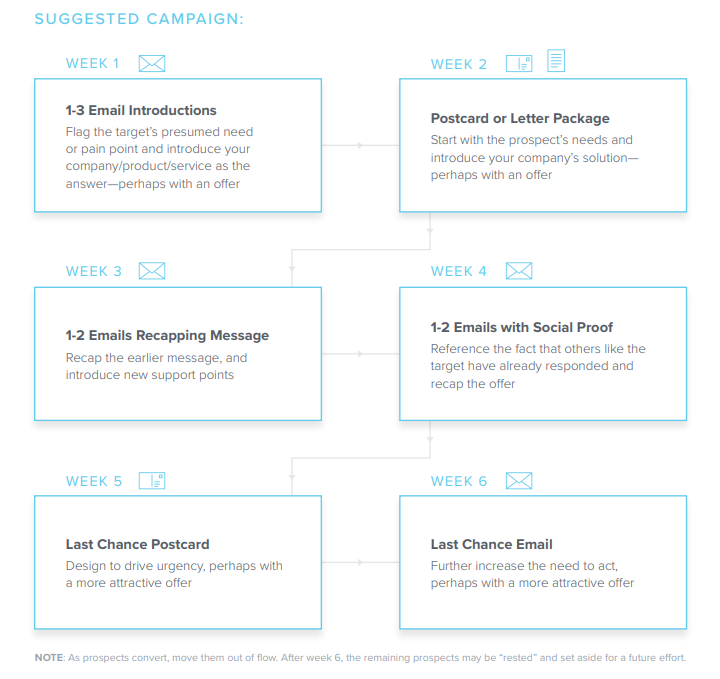
#2) Stay Top of Mind Nurture Campaign

This direct mail campaign is perfect for sending to prospects and leads that you have been in communication with, but are not currently at the point where you are ready to pass them off as a sales qualified lead. It can help you to stay in touch with prospects and make sure that you are in the right place, at the right time — when your prospects are ready to buy.
When prospects are ready to buy can be a tough thing to gauge. Sales cycles are all over the board, taking between one week and one year, based on a wide range of different factors. Sending campaigns that help you to stay top of mind ensures that your prospect thinks of you the next time that they look for a similar solution.
With this campaign, your goal is to consistently deliver valuable, attention-grabbing materials. Our recommendation is to again combine both email marketing and direct mail into a seamless campaign that engages leads through multiple channels.
- Week 1: Postcard Recap. This campaign begins with a postcard recap of your product or service. Highlight the pain points that your product solves. Tie those issues directly to features of your offer. Make sure that prospects know that your solution is uniquely positioned for companies in their situation.
- Week 2: Email Case Study. Deliver social proof that speaks to their situation. A case study from a similar company (in the same industry or experiencing the same problem) can be a powerful way to drive home the value that your product can deliver to their business.
- Week 3: Letter Check-In. A personalized letter can go a long way toward earning a lead’s trust. Check-in with a personal letter that leverages what you know about their business to stay top of mind and establish trust.
- Week 4: Email Offer. Deliver high-quality educational content. This is the perfect chance to deliver your white papers, ebooks, case studies, product sheets, or other relevant materials that can help your prospects to better understand your offer.
- Week 5: Additional Offer. In week five, we recommend segmenting your list based on who has responded to previous touches in this campaign. Those that have responded could receive more sales-focused materials or personal outreach offering to ask questions or clear up any confusion they may have about your offer. Those that haven’t responded could receive more educational materials.
- Week 6: Direct Mail Special Offer. Send an offer that will entice them to buy. Special discounts, free trials, or a personalized demo can be a great way to draw them in and capitalize on the fact that you’ve stayed on top of their mind for the last month and a half.
This campaign is specifically designed to continually deliver helpful materials to your audience at a pace that will not overwhelm them. If they’ve already been through other campaigns and have yet to buy, this campaign can be a great way to continue to build a relationship without making them feel pressured.
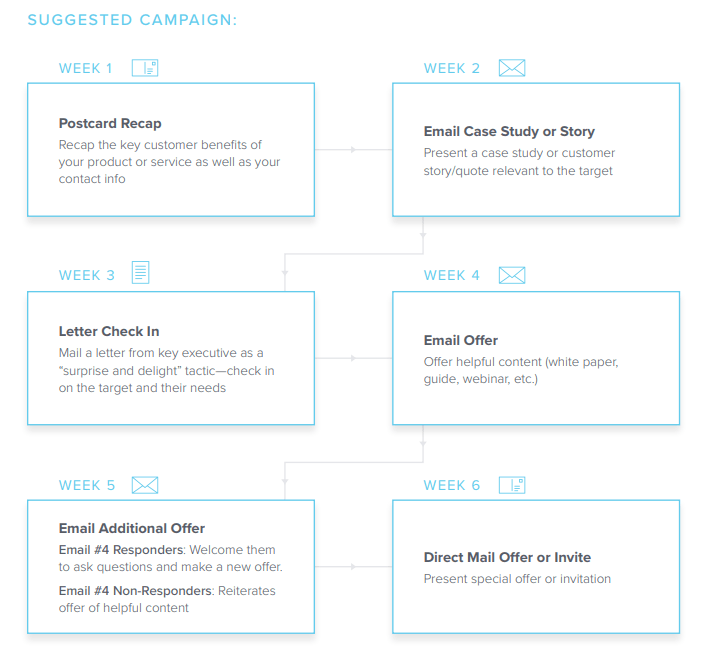
#3) New Lead Nurture Campaign

How do you connect with warm, new leads that are not ready to buy or engage with your company? A continuous stream of warm leads is vital to the health of any organization. However, knowing how to keep those leads warm and appropriately guide them through the decision-making process is just as important.
This direct mail campaign allows you to stay in continuous communication with your audience over a longer period of time. While these leads may be warm, they will need consistent nurturing to go from “warm” to “ready-to-buy.”
The focus of the campaign is on making a positive first impression with your leads. Then, you build on that initial trust by delivering high-value educational materials that not only inform them about your product but endear them to your company. You want to be present without being overbearing or pushy.
Here’s our recommended campaign for new, warm leads:
- Week 1: Email Welcome. A quick “Welcome” email acknowledging that they are a new lead that has entered your sales ecosystem. Let them know who you are, how you can help them, and let them know that you have valuable materials that will be coming their way soon.
- Week 2: Direct Mail Benefits Letter. Send your leads a personalized letter that explains the benefits of doing business with your company in full. Highlight pain points that you know they are experiencing and position your offer as a solution to those problems.
- Week 3: Call to Action Through Email. The goal of any nurturing campaign is not just to build familiarity and trust with leads — its to call them to action and get them to engage with your materials. Send them a survey, quiz, questionnaire, or any other material that will get them to provide you with more information about them and engage with you.
- Week 4: Direct Mail Postcard Benefits Recap. In week four, deliver a postcard that acts as a summary of the benefits that you highlighted in week two of the nurture campaign. Tie your benefits directly to pain points that your solution will solve.
- Week 5: Email Testimonial. Deliver a testimonial or case study that highlights the experience that a similarly positioned company had with your product or service.
- Week 6: Email & Direct Mail Special Offer. Deliver a two-channel, one-two punch that ensures that your special offer is noticed. That special offer could be an invite to hop on a call, a coupon code that provides them with a discount, or a free trial offer to see how your product suits them.
- Week 7: Email Follow Up. If your lead does not respond to your special offer, then reach out through email to re-establish a connection and make yourself present for questions or concerns. Remind them of the special offer.
- Week 8: Email News. Deliver a news item that is relevant to your company, offer, or industry. Stay top of mind and continue to deliver value in a low-pressure way.
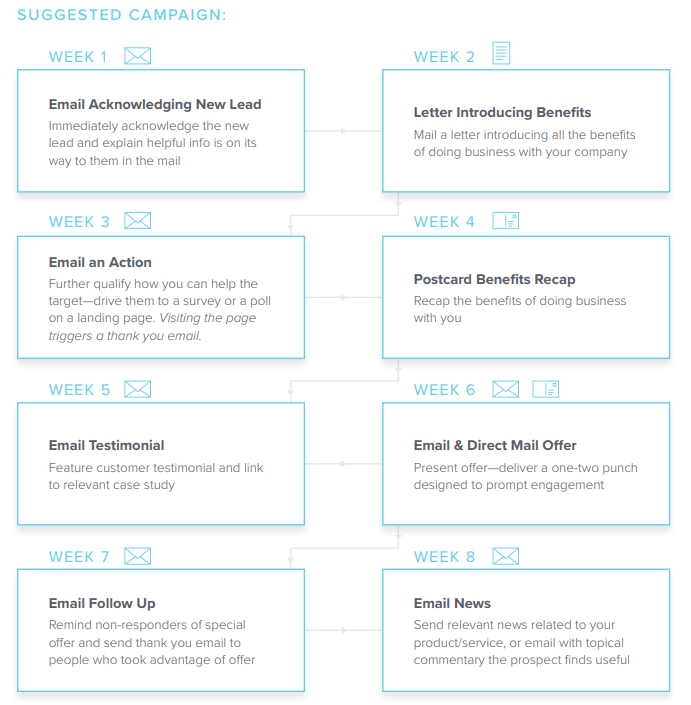
#4) Seal the Deal Onboarding Campaign

Having a solid onboarding strategy in place is critical for turning first-time buyers into long-time customers. When a customer buys your product, they enter the “honeymoon period” with your company and product. Your goal during this phase has to be to continue to build your relationship, guard against second thoughts that they may be having, and lay the groundwork for a positive experience moving forward. Great onboarding leads to more referrals and endorsements from your customers.
This direct mail campaign is designed to make your customers feel welcome in your presence. By leading with an email teaser and attention-grabbing direct mail delivery, you not only keep them engaged with your product, but you help to cement the relationship moving forward.
This campaign is delivered over a much longer period of time. The bulk of the campaign is sent in the first seven weeks but continues up to one year. We want to walk them through the process of integrating your solution into their business without being overbearing.
- Week 1: Email Teaser and Direct Mail. Thank them for buying your product. Ask them to keep an eye on their mailbox in your teaser, then deliver a small gift with physical onboarding information that walks them through the process.
- Week 2: Email Links. Deliver any digital links that can help them with the onboarding process and provide relevant information.
- Week 3: Direct Mail Letter from Executive. A personalized letter from an executive at your company can go a long way toward building trust. In the letter thank them for buying your product, ask if they need assistance, and make yourself available to answer any questions that they might have.
- Week 4: Email FAQs. While you might make a FAQ page available on your website, delivering answers to frequently asked questions can be a great way to limit customer service requests and ensure your customer shave the resources that they need to be successful with your solution.
- Week 7: Email Survey and Postcard. Now that your customers have been using your product for nearly two months, it might be a good time to check in and solicit some feedback from them. Deliver a short survey through email to see what their thoughts are. Then, send them a postcard through direct mail if they don’t respond to the survey.
- Week 6: Email & Direct Mail Special Offer. Deliver a two-channel one-two punch that ensures that your special offer is noticed. That special offer could be an invite to hop on a call, a coupon code that provides them with a discount, or a free trial offer to see how your product suits them.
- Week 26: Half-Anniversary Postcard. Your customer has now been with your company for half a year. They probably don’t even realize it! Send them a postcard that celebrates the anniversary and package in a relevant special offer or upsell opportunity. Additionally, you can use this touchpoint to ask for referrals.
- Week 53: Letter Anniversary. It’s been one year! Send them a direct mail letter thanking them for being your customer.
This onboarding campaign seamlessly ties email and direct mail together to consistently stay in touch with your customers and deliver the information that they need to get as much as they can out of your product.
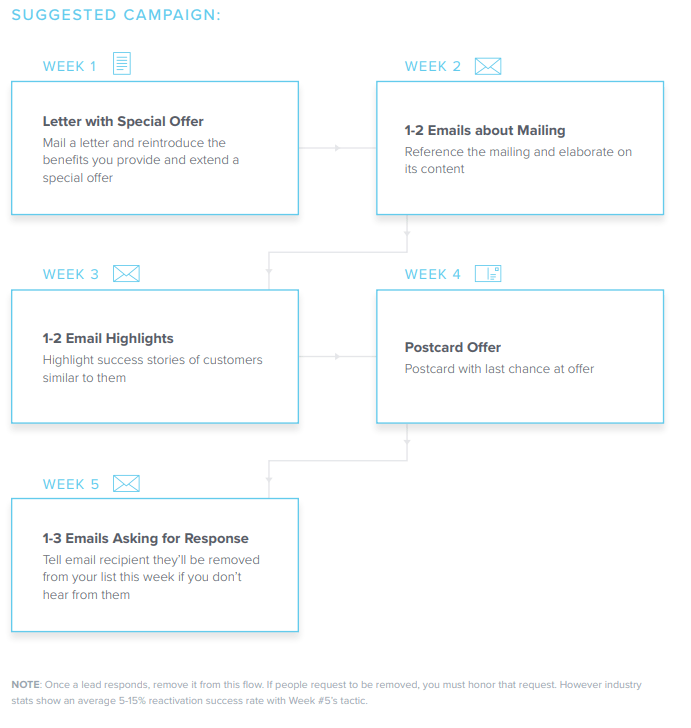
#5) Raise the Dead Cold Lead Touches Campaign

Too often companies will completely purge cold leads from their system in an effort to clean up their databases and streamline their marketing efforts. In actuality, they should be sending cold leads into a separate workflow that addresses their specific needs. Cold leads are frustrating. They’ve demonstrated interest and failed to convert, often for unknown reasons. Still, a small percentage of cold leads can still be converted into customers with the right campaign.
Often, cold leads will have ignored your previous emails. It’s the job of this campaign to grab their attention and foster engagement with your company. This direct mail campaign kicks off with a short letter in an envelope in an effort to recapture their attention and reactivate these leads.
- Week 1: Direct Mail Letter with Special Offer. Re-introduce your company and the benefits that your solution provides. Send a special offer that convinces them to take action.
- Week 2: 1-2 Emails about Your Letter. In week two, deliver emails that discuss the contents of your letter. Focus on the pain points that your solution solves and dive deeper into specific benefits that were mentioned in the letter.
- Week 3: Email 1-2 Customer Success Stories. Send your leads testimonials, case studies, or stories about customers that have worked with your company and seen success from your solution. Provide social proof.
- Week 4: Direct Mail Postcard Last Chance Offer. Create a sense of urgency with a last chance offer. Convince them to take action.
- Week 5: Emails Asking for Response. Send 1-3 emails in week 5 asking for a response. Let them know that they will be removed from your mailing list if they do not.
This short and simple campaign combines the benefits of email and direct mail to grab the attention of cold leads, remind them of the benefits that your product brings to the table, and re-activate them.
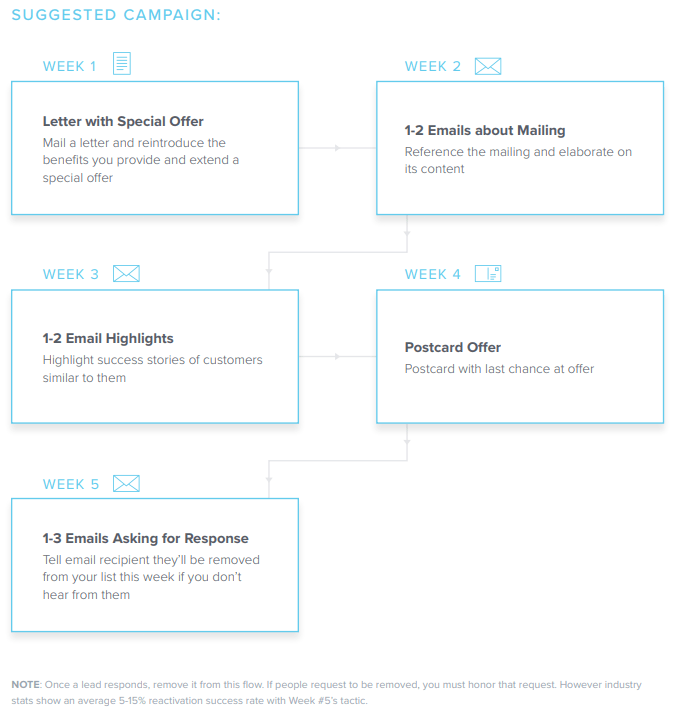
#6) Prime the Pump for Events Campaign

When it comes to running professional events, your ability to clearly communicate with your registrants, invitees, and interested parties will play a critical role in the success of your event. Many of these people will turn out to be qualified prospects and leads if you can successfully get them into your sales funnel.
Running a successful event requires that you communicate early and often. This campaign uses direct mail and email to deliver a consistent stream of reminders and event information that will keep them engaged both before and after the event.
- Week 1: Direct Mail Letter Introducing Event and Email. Send both a letter and an email that introduces the event and provides some basic information about what they can expect from attending. Provide a landing page URL so that you are able to capture information.
- Week 2: Postcard Reminder. Send a postcard through direct mail that reminds them of the date, time, and information about your event.
- Week 3: Email Event Information. Remind them why they should attend your event. What kind of benefits will they receive? Invite them to visit your booth.
- Week 4: Postcard and Email Reminder. Send another reminder through both direct mail and email about your event. Provide information such as the event showroom layout and other vital information that will improve the event for them.
- Post-Event: Thank You Postcard and Email. After the event wraps up, thank them for attending your event through both direct mail and email. Email followup information to anyone that did not stop by your booth or see you at the event.
- One Week Later: Event Recap. Deliver content that recaps the event. Recap key points from the event and deliver a special offer to attendees.
This campaign provides a simple but direct way to ensure that you make the most of your event and connect with as many prospects as possible.
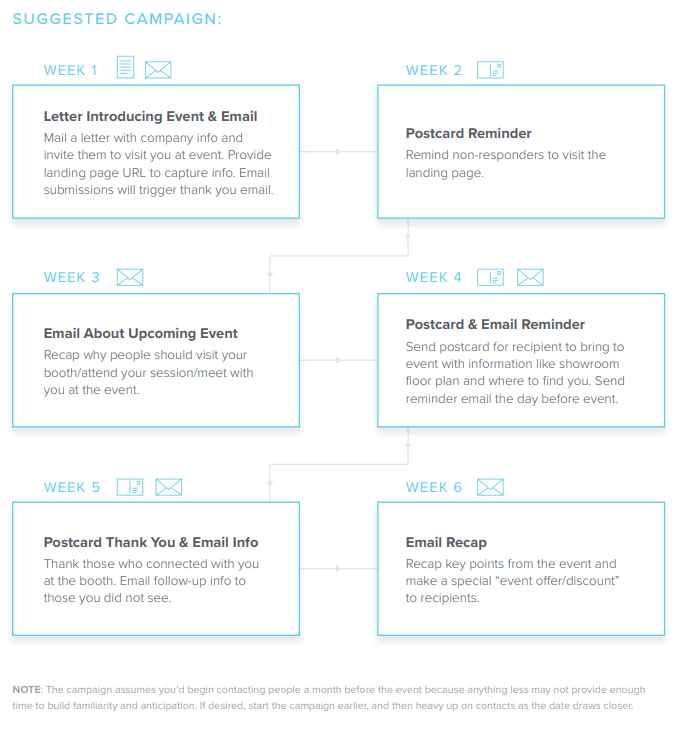
Try A Direct Mail Campaign. Experiment, Learn & Improve
Since automation removes much of the hassle from the production of direct mail, the barrier to setting up direct mail test campaigns has plummeted. Use these 6 proven campaigns to get your testing program off the ground.
It’s easy to get started. Just sign up for a free account, upload or purchase a list right through the app, set up your creative and press send.
Interested in learning more?
Watch Direct Mail Automation Overview Video
About the Author

Dennis Kelly
Dennis Kelly is CEO and co-founder of Postalytics, the leading direct mail automation platform for marketers to build, deploy and manage direct mail marketing campaigns. Postalytics is Dennis’ 6th startup. He has been involved in starting and growing early-stage technology ventures for over 30 years and has held senior management roles at a diverse set of large technology firms including Computer Associates, Palm Inc. and Achieve Healthcare Information Systems.
